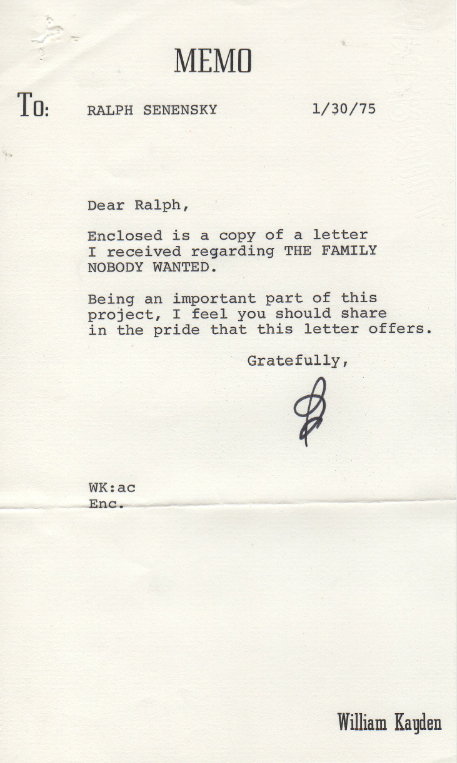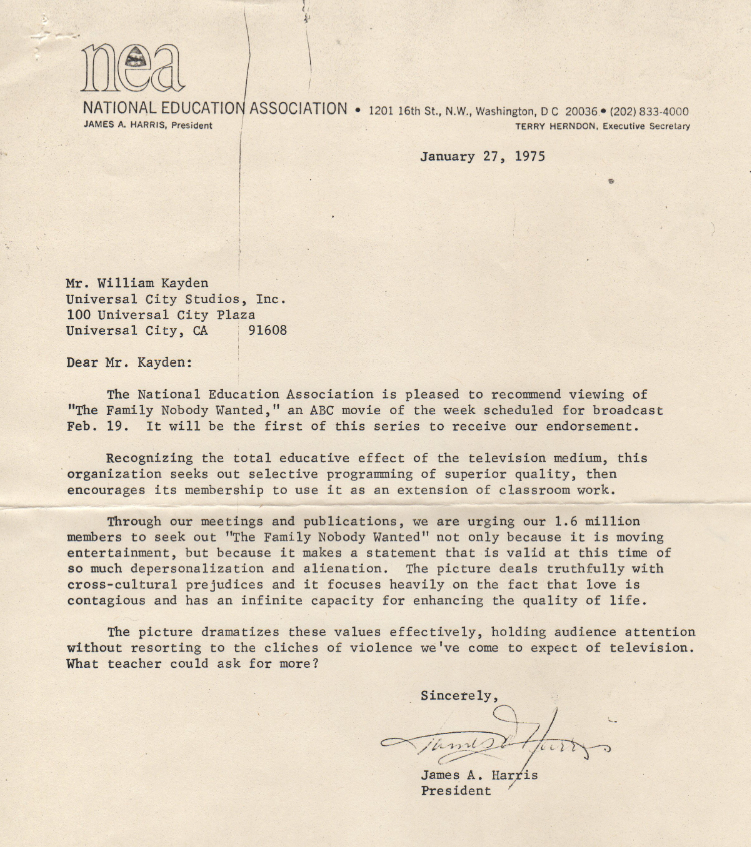FILMED December 1974
I don’t remember having any conversations about whether THE FAMILY NOBODY WANTED was a possible pilot for a series. At that time practically every movie made for television was, if not contractually at least hopefully. And in the wake of the success of THE WALTONS, the search for family fare was definitely on the wish list at all three of the networks.
That was the first shot of Lynette as a member of the Doss family. There had previously been the introductory shot of her sitting by herself on the grounds of the orphanage as the head of the orphanage spoke of her. But without the scene at the bus depot when Helen returned with THREE adoptees, for the audience the girl lying on the bed crying could have been Karen, Pam or Debbie, anyone of the three previously adopted Oriental girls.
I directed many productions with child actors, but never did I have as many as in this film. Not counting Andy, the baby, there were eleven of them. As a result I didn’t have the time to connect with them on a more personal level and give them the individual attention I usually would. I had that advantage with Willy Aames, because earlier that season Willie had guest starred for me in an episode of THE WALTONS. Later we would work together again when he was one of the EIGHT IS ENOUGH. Ernest Esparza (Rick) was new, but we would work together again later on THE WALTONS, when he appeared as the Indian grandson in THE WARRIOR.
THE WALTONS seemed to have been the training ground to be cast in this film. Beeson Carroll (Mr. Collins) had earlier that season guest starred on THE WALTONS in the same episode in which Willy Aames appeared. He had played Willy’s father.
When I posted THE FAMILY NOBODY WANTED on my blog (RALPH’S TREK) in 2010, a viewer left the following comment:
Somehow I missed this film when it aired, but I wish I hadn’t. Olson’s sincerity really sells one on the story. (Although, for me, it was distressing to picture kindly Shirley Jones making a baby cry! I may never recover.)
He was referring to my telling of how I was told by a social worker on the set of A DREAM FOR CHRISTMAS that the way to make a baby cry was to make crying sounds to which the infant would respond. Since I learned that a woman’s voice worked better than a man’s, Shirley was responsible in the infant crying scenes with making the baby bawl. You would have learned this if you had read my posting of THE FAMILYH NOBODY WANTD: Part I.
There was an amazing resemblance between this script and A DREAM FOR CHRISTMAS. In both a minister and his large family arrive optimistically at his new church, only to face a major problem. In the earlier film the church was in dire financial straits and was soon to be torn down to make way for a shopping center; here the mixed racial makeup of his family presented a devastating obstacle to his finding permanent employment. The sets for the two parsonages were almost interchangeable, and for the family to make them livable required the application of a lot of “elbow grease.” Finally both films had a climactic scene where circumstances force the minister to make a difficult decision.
One of the duties of the script supervisor when filming was to see that all action matched. If an actor took a bite of food before or after speaking in the master shot, he had to do that in all subsequent angles. I had a dinner table scene with Carl and all twelve kids. I requested that since the family was so financially strapped, the dinner plates should not be a set. I wanted them to be all different colors. I realized this would add to the chores of the script supervisor, since for editing purposes the action from take to take had to match. For instance if in the first angle filmed, one of the youngsters was holding or passing a plate as he said a line, he had to do that in every angle on him that followed and the color of the plate also had to match. I don’t know why, but I took a special glee in planning this. And with even more people at the table than in the Walton household (and being used to the confusion involved in filming those family dinners) I expected completing the sequence would be difficult. But it wasn’t. The discipline, the concentration of those youngsters was a joy to behold. I must add that in addition to filming, all eleven of the kids were spending three hours a day in school.
That meeting was also filmed on location at the church on the third day. It was a scene that could have been filmed more easily on a soundstage, but in laying out the schedule, the sermon at the church and the two exterior shots amounted to only three and a half pages. It would have been a waste of time to move back to the studio to complete a full day of filming. So a room was found at the church where the meeting could be filmed, as was the earlier office scene between Carl and Helen.
For all my carping about Universal, I admit this time there didn’t seem to be their usual reticence with opening the pocketbook; in fact I think we mounted a very respectable production. The setting for the bazaar was on the back lot, and I was especially pleased with the abundance of extras provided to people the festivities.
Lindsay Workman (Judge) was another “graduate” of THE WALTON finishing school for actors. He had appeared for me as the owner of the stationery store in THE MARATHON, one of my favorite productions. He passed away two months ago.
It seemed every studio’s backlot had an exterior courthouse with tall stone columns and wide steps. The fact that the Universal courthouse was far more imposing than our small community of Franklinburg would probably have had couldn’t matter. In television as far as courthouses went, one-size-fits-all.


It is said that art imitates life. Wouldn’t it be nice sometimes if it could be the other way around — that life would imitate art so that everyone would live happily ever after, like in the movies. After the twelve children were grown Helen Doss and Carl Doss were divorced.
The journey continues



I just found this when I was looking up the book. I never realized it was a movie of the week. It looks like you did a great job with it. I wish it was available on DVD
If you watch all of the clips for THE FAMILY NOBODY WANTED: Parts I and II, you will see the whole movie.